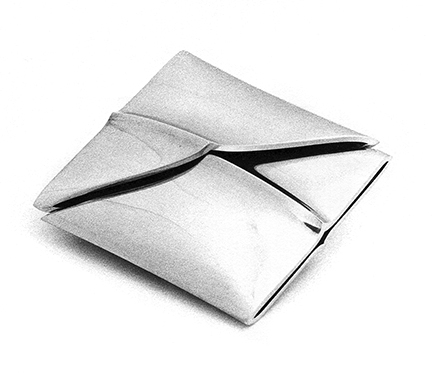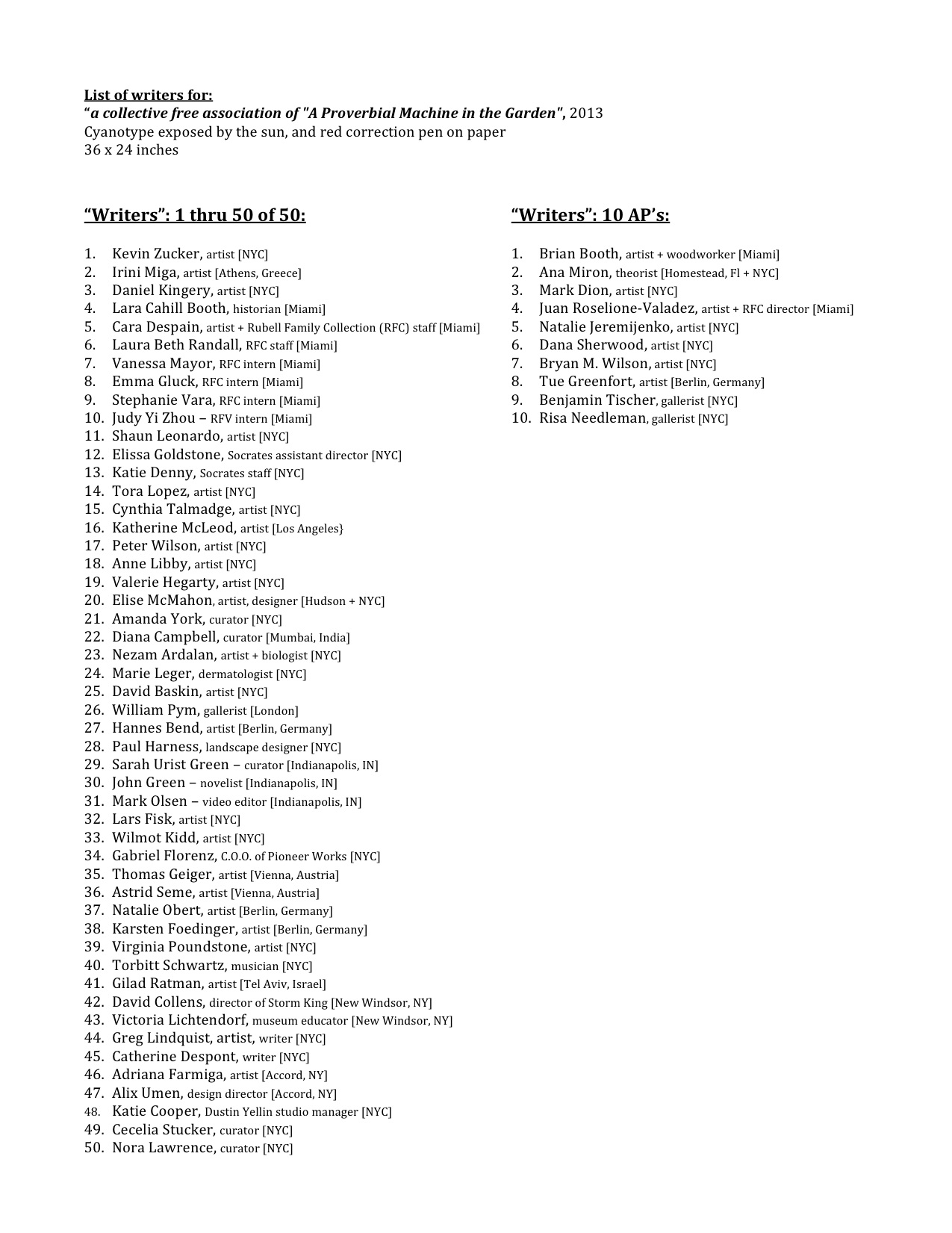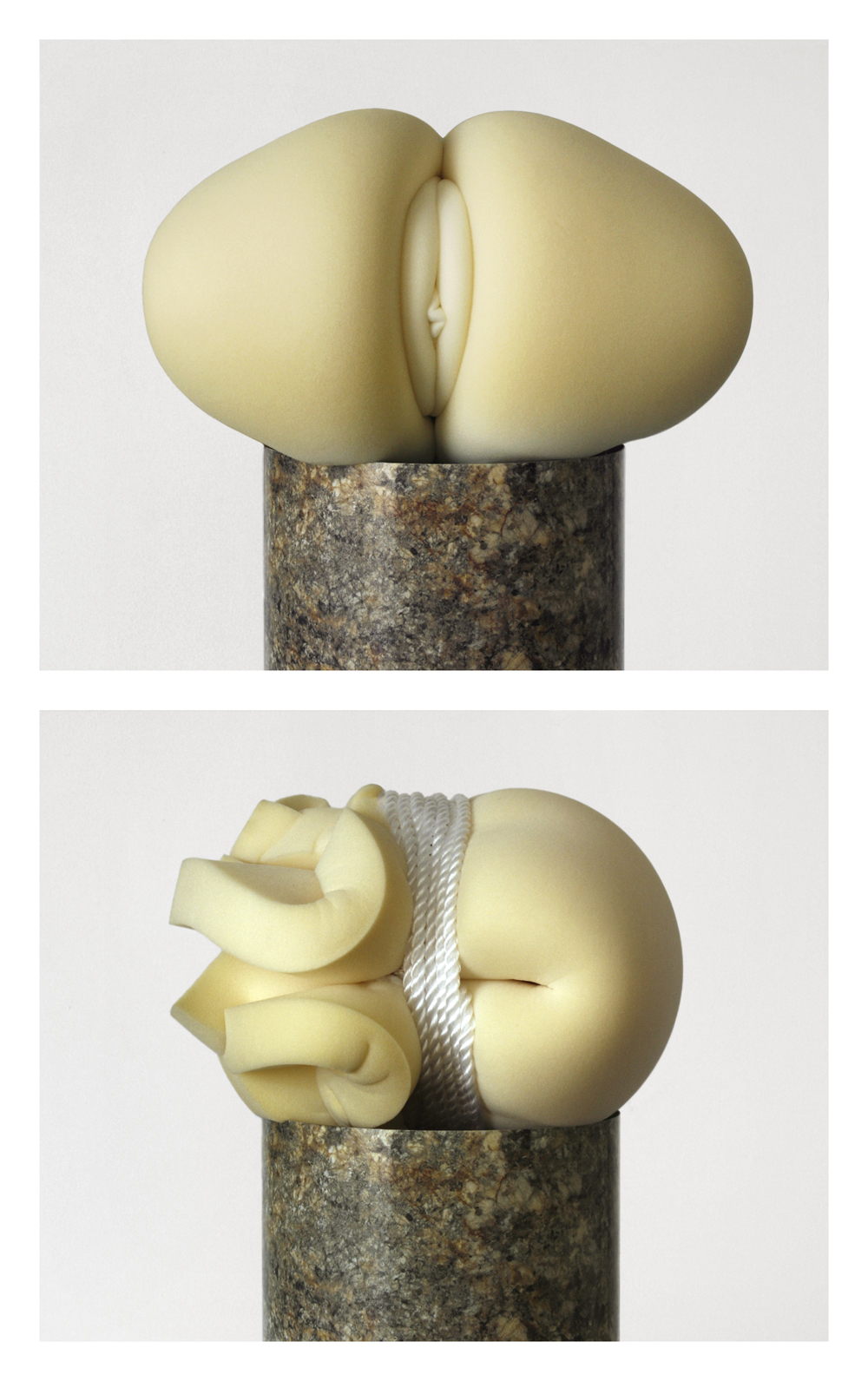Archive for the ‘Uncategorized’ Category
Going Virus.
November 1st, 2013
November 2013 curator Barry Rosen interviews artist James Hoff. It’s a virus.
Backseat
October 1st, 2013
Chrisy MacLear interviews artist Jonathan Paul Gillette for the October 2013 edition of the Artist of the Month Club.
note: this conversation/interview took place in backseat of jonathan paul gillette’s 2002 nissan pathifinder cadillac, as Christy MacLear (the interviewer) and Jonathan Paul Gillette were driven around the city.
Christy MacLear:
So we’re here in your “nissan cadillac” and I want to talk to you about your work, first, and second the more philosophical position about the ideas of consumption, identity, envy and aspiration to name a few. So Jonathan, tell me first about this photograph:
Jonathan Paul Gillette:

The photograph is of my everyday automobile, a 2002 nissan pathfinder. i took photos of a 2012 Cadillac escalade, set them up as a car wrap and hired a local signage business to apply the wrap to my automobile. for the past 2 years, my former automobile has been concealed, covered by images of a 2012 Cadillac escalade. my former automobile is now neither a Cadillac escalade nor a nissan pathfinder. it appears to be a Cadillac that swallowed a pathfinder or a pathfinder wearing the skin of an escalade – not fully either, but tethered to both, it negotiates the inevitable compromises that go along with performing an identity.
As a photograph, its function is similar to a high school fantasy poster: aspiration images of Ferraris, Lamborghinis, Porsches that aided in propelling the identity crisis of adolescence, fantasies always seen alone with their reflection in a black void.
The vehicle was photographed in a psyche room, left to reflect its own moratorium.
Unlike an imitation Louis Vuitton bag, which is fixated in a symbolic role, my vehicle seeks the real. it is attempting to inhabit something other than itself without changing.
As my reliable mode of transportation, it suffers an identity crisis, a crisis which it assumes as a role in the midst of others seeking their own roles of viewership
For example, the other day i found my tire flat. after rolling up on a spare, i sat and watched employees take photos and pose beside my automobile. as i went outside to retrieve my automobile, an employee drove it up and upon getting out threw me the keys. in a muffled, proper voice he said, “your escalade, Mr. Gillette.”
I love how he chose to participate in the theater of it, a theater rooted in Edward Bernays.
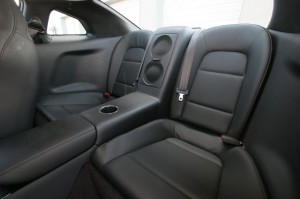
On another occasion, i was pulled over for running a stop sign. the officer remained in the patrol car for over 15 minutes. finally, the officer approached very cautiously, asked for my license, registration and insurance, and then offered a suggestion: “if i were you, i would remain calm and whatever you do, do not get out of the car.” she returned to the patrol car and, after another 20 or so minutes approached the front of my automobile, squinted at the hood, and walked around the other side, touching it and picking at the image, even stopping to look underneath the vehicle. returning to my window the officer asked:
“what kind of vehicle is this? you will have to remove the wrap as you are impersonating another vehicle. i’m not sure what law you are breaking, but…..you are breaking some law.”
CM:
With that explanation – I wanted to challenge you by asking: Isn’t a cadillac not just a car but a hypothetical level of luxury – yet funnily not on that level of luxury itself? Meaning the term “its the cadillac of the xx…or yy” but yet our contemporary culture doesn’t really value cadillacs as the best car itself. What do you make of that?
JPG:
I appreciate what you’re pointing out here and am tempted to simply agree – it is certainly a hypothetical level of luxury, but the question is: for whom is it hypothetical, and for whom isn’t it hypothetical? that is what i do not know, and, further, i do not know how to begin to assess what level defines luxury.
Perhaps it is possible to ask here: in order to have a hypothetical level of luxury, to prove the hypothesis, must someone believe? and then, if this is the test, is it a what or a who that is to be tested? in other words, where, or at what level does this hypothesis lie?
Certainly the manner in which the Cadillac is set in relation to other lines in the GM family, demonstrates that, in a way, you are correct. it is a construct for attenable luxury.
Perhaps the attainable thing lies in the experience – which becomes difficult to see if only at the level of wondering what lies inside, and what remains outside the experience. further, can the supposed real space be found in either distinction – inside, outside? is it, perhaps, in between? there is the inside and outside of the disguised automobile, of course, but this is only an envelope.
 My great grandmother believed that Perry Mason was a real lawyer. she would tell others about his methods and brag about watching him win in court. “that Perry Mason,” she would say, “he never lost a case.”
My great grandmother believed that Perry Mason was a real lawyer. she would tell others about his methods and brag about watching him win in court. “that Perry Mason,” she would say, “he never lost a case.”
And what i think about is:
Which experience is the more real, hers or mine? the fact is that Perry Mason is a show or an image that i myself constitute in an imaginary dimension. i can never have the supposed real experience that she is privy to. is it possible for me to be in my great grandmother’s position without having to fabricate a construct in the attempt? i often think about how i am the one that is fooled and not privy to the facts of the matter.
CM:
Jonathan I think of your work as linking identity to the timely topic of appropriation. You had another work which converted blue light special shoes into air jordans. Tell me about the root of this work.
JPG:
As for the piece you mention, nikes: kmart purchased the brand British Knights, and shifted its style by interpreting older styles from Nike. i purchased a pair from kmart and made them appear to be Nikes with materials i found around my apartment.
A classmate of mine in high school took a kmart backpack and with white-out, painted a swoosh over the other brand emblem. from a couple feet away it posed as the real thing. close up, you could see the cracking in the white-out.
I remember people talking about this from a distance, but no one conversing with the student about the gesture. it had a profound impact on me, though. when something acts inauthentically, it demands attention in illuminating the feeling that there is a deficit.
What was his motivation? was he interested in: the design, the status, the ownership, the act of changing, the act of defacing, the act of mark-making, or simply fitting in?
His backpack is beyond what it tried to fit in with insofar as it easily could be seen as: the newest, rare, foreign, special, limited.
What was his investment and who was his investment for? and basically, who is at the helm of his ego ideal?
Is it a failure?
What is the outcome for all participants of an appropriation? what makes the appropriation a success or a failure?
CM:
I have known you for nay 15 years now I think – right Jonathan? Well I know you are a deeply religious person, very close to your family and have taken a different path of teaching and thinking. Correct? Tell me where this has taken you and why the cadillac piece is important as a part of your journey.
JPG:
The 2002 nissan pathfinder escalade, which is neither an escalade nor a pathfinder, but more of a frontier, occupying a kind of border space, mirrors my relationship to the question you ask. all answers seem to run contrary to the truth and as i begin to respond, i feel i betray everyone involved in my life. i feel all stances i might take in responding will be inadequate. there is no perceivable satisfactory posture to assume. for me the question lacks an identity.
CM:
Jonathan, I want to welcome you to New York. I’m not sure the world is ready for what you have to unleash for us. We’re all here to learn and we have you to guide us. So I’m proud of you and your journey.
Drive a rusty nail through a lemon to ward off the evil eye
September 1st, 2013
Aaron Moulton interviews artist Jason Metcalf for the September 2013 edition of the Artist of the Month Club.
Click the image below to hear the interview.
For Margaret
August 1st, 2013
Curator Jonathan Berger interviews artist Stefanie Victor for the August 2013 edition of the Artist of the Month Club.
—
Stefanie Victor lives in Woodside, Queens with her husband, the designer Julian Bittiner. They both make all of their work at home, in two bedrooms, which they use as their studios.
I met Stefanie in 2006 at the Macdowell colony, at which time she was making detailed drawings of magnified textures from sweaters and other textiles she owned. We’ve remained close friends and central to many of our conversations is an interest in privacy, and the benefits that privacy affords us as creative people.
I have come to realize that while our conversations are rarely explicitly about contemporary art, they contribute to my own idea of what is meaningful now. What Stefanie and I are doing is by definition, contemporary, and yet I think we often feel that who we are and what we do is misaligned with the prevailing value system around creative production.
I had never seen Stefanie wear jewelry until she and Julian became engaged. Instead of a ring, he bought her a necklace made of four loops of linked chain. The necklace inevitably rearranges itself on Stefanie’s body because its structure is unstable. She futzes with it every time I see her, and because of these two things–her wearing it and touching it–the necklace is in a sense as a sculpture constantly being transformed.
I recently asked Stefanie about her current work. Below is our conversation.
—
Jonathan Berger: When I think about how I would describe your recent work, including the small object that you have produced for the AMC edition, I find myself at a loss, or more accurately, with a wealth of different possibilities. These objects could be sculptures, but their physical identity in terms of scale, material, association, etc., keep their identity fluid. They could be sculpture, jewelry, a functional object like a paperweight, etc. Could you talk about how you might describe or classify what you are making?
Stefanie Victor: I would say I’m making fairly conventional art objects, at least in the sense that they have no hybrid status really. They’re not like a Donald Judd bed that looks like an art sculpture but you can actually sleep in it. You can’t put these sculptures on, and as a paperweights they’re a bit light.
But yes, as art, they’re intended to refer to qualities that are often found in other types of things. They might bring to mind something that can be worn, and I hope they might also might elicit desire, which I think is something we’re more comfortable with as a response to consumer goods than to artworks. Also, their small size is typical of tchotckies or keepsakes – things that are meant to remind you of trips or explicitly to decorate your home.
JB: We often talk about intimacy in relation to both of our creative practices and the experiences we want to give others. These concerns permeate everything I have seen you do. How do they manifest in the new work?
SV: I think we have a different relationship to the things we have in our home than to what we see in the ‘neutral’ setting of a gallery, museum, or even a public space, not that these are bad places for art. We live with the things in our homes, we often touch them, we move them around, and we usually remember under what circumstances they were acquired – where, with whom etc. My hope is that the small scale of the sculptures, which lends them to easy placement on bookshelves or windowsills might draw out those kinds of associations, even if a domestic context is only imagined.
You mentioned I only began to wear jewelry when I got married. Before that, jewelry seemed superfluous, non-essential, and at worst about displays of wealth. When I got married two years ago, I realized how jewelry can be intrinsically linked to meaningful people and events. That connection – direct, emotional, personal – is something I’m always wanting with art. In borrowing from the material, and often, structural vocabulary of jewelry, I’m hoping to shift the sometimes removed viewer/art-object relationship more toward the owner/jewelry-object one, something more intimate.
JB: Could you talk about your interest in Margaret De Patta and other historical figures who’ve informed your recent work?
SV:I came across Margaret De Patta’s work in a book on the history of craft. The image in the book was of one of her pendants, a really beautiful, precise, geometric arrangement of quartz and metal photographed against a solid background. The author made of a point of noting that De Patta never shot her work on bodies because she wanted it to be seen as sculpture. Through De Patta, I found other artists like Françoise van den Bosch whose work is well known in the discipline of jewelry, but not so much fine art.
I’ve been interested for a while in those kinds of parallel trajectories, particularly in the 60s and 70s. A lot of other artists I’ve looked to from that time, like Lygia Clark, Scott Burton, Ruth Vollmer, and Franz Erhard Walther, were thinking about not only vision but touch; not only theory but day-to-day experience, something these studio jewelers were directly engaged in as well.
JB: You’ve said that you don’t think of the piece you’ve made for AMC as an edition, but this isn’t because each piece is unique. Why is this significant for you?
SV: I really wanted each piece that people received to be “the real thing,” as opposed to a lesser copy or documentation of a thing. I originally worked out this shape in pipe-cleaner, had hands-on help forging a model from copper from Sung Qu Park, an amazing silversmith, and then worked closely with a caster. For me, the cast pieces are the only finished sculptures.
Single Asparagus
June 1st, 2013
Karen Archey interviews artist Lucie Stahl for the June 2013 edition of the Artist of the Month Club.
KAREN ARCHEY: You’ve employed the flatbed scanner as a primary tool in your artistic practice for years; your work often being likened to a digital-age photogram. Can you speak about your decision to utilize this rather specific image-making tool?
LUCIE STAHL: I’m quite an impatient person so the immediacy of the process is nice.
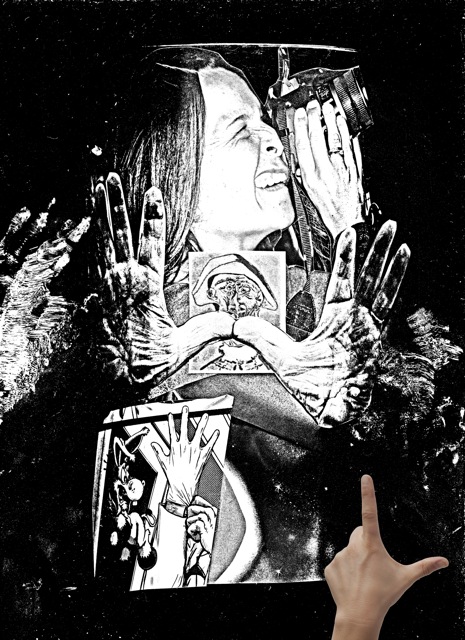
It is of course a bit like making photograms but without the inconvenience of having to stand around in a dark room full of chemicals all day. It gives me time to do a lot of stuff I’d rather be doing than making art. I’m often asked about the process and presentation of photography in relation to my work and the usage of the scanner, but my work is not necessarily about photography. Of course it is unavoidable but it’s just not something I think about. I think more about the stuff that surrounds us in general. Photography is one of those things. I don’t really distinguish between the frame and the content.
KA: Your hands make frequent appearance in your compositions. Sometimes they hold down images or objects onto the scanner, other times they’re covered in clay or appear as numerals, such as your piece here. It makes me think about facture, or “evidence of the artist’s hand,” a traditional concern in artistic production. It also references portraiture to me, the hand being a fairly gender-neutral part of the body, scanner being a new way to picture the body. Are the hands in your work symbolic of such concerns?
LS: Yes. The artist’s presence – it is sort of a joke, with this kind of image making, but a serious one, too. I’ve considered asking people with prettier hands to do the job, but somehow I always come back to my own mitts. I like your description of the hands as being gender neutral.
I’m almost tempted to say it is also age neutral. I always think my hands look like baby-grandpa hands.
I’ve recently been to the Museo Nacional de Antropología in Mexico City and they have all these great ceramics of hands and feet. There’s something very humble about that. Human, I guess. Like the prints in the Chauvet caves. What a wonderful movie. I can’t believe I missed to see it in 3D. Herzog’s a genius. I like assholes. I’m very literal, I don’t do abstraction.
KA: Speaking of serious jokes, your work has previously employed lines from famous comedians printed onto text and placed on the scanner. A lot of these lightheartedly broach very serious topics–how do you use humor as a tool in your practice?
LS: Correct me if I’m wrong, but I think I’ve only ever used quotes of one famous comedian – George  Carlin – in some of my early scanned works. Watching his stuff was a bit of an epiphany for me. We don’t get much good Stand Up in Germany. Since then I moved on to other Stand Up Comedians. I like Kristen Schaal. I might have stolen or borrowed the occasional idea or used a similar text structure, no doubt. But yeah, I consider all those texts I wrote for the posters „serious jokes“. Or, almost all. Some of them are sheer sillyness. The joke, or humor, makes it possible for me to talk about, – I’m hesitant to say it but out of lack of another word I’ll call it – moral issues, without blushing. Someone told me I’m not a moral person but I’m morally hardwired. I can’t escape it. I don’t really know what it means but I agree.
Carlin – in some of my early scanned works. Watching his stuff was a bit of an epiphany for me. We don’t get much good Stand Up in Germany. Since then I moved on to other Stand Up Comedians. I like Kristen Schaal. I might have stolen or borrowed the occasional idea or used a similar text structure, no doubt. But yeah, I consider all those texts I wrote for the posters „serious jokes“. Or, almost all. Some of them are sheer sillyness. The joke, or humor, makes it possible for me to talk about, – I’m hesitant to say it but out of lack of another word I’ll call it – moral issues, without blushing. Someone told me I’m not a moral person but I’m morally hardwired. I can’t escape it. I don’t really know what it means but I agree.
KA: Your new images of trash cans remind me of a teenager’s bedroom wall collage, or a piece of furniture wheat pasted with images cut out from magazines. They feel pretty intimate and residential, and remind me of our yesteryears collecting magazines and National Geographics for collage source material. Do you primarily work with printed material? And why use a residential object such as a waste bin?
LS: Yes, the trashcan collages are very pre-pubescent.
All the material collaged on there is stuff that I collect from magazines and newspapers. It might be yesteryears’ material but it’s still stuff around, so it’s nice to use it. I like the idea of reading the newspaper in print but then I feel guilty when they pile up cause I end up just flicking through the online version, so going through them one more time seems appropriate. Isn’t there a very silly movie about somebody reading each newspaper to the fullest and therefore always is years behind?! I guess it was a short story once in the New Yorker. I didn’t even like it so much but somehow it got stuck in my brain. I hardly ever read the old news though.
I also still like what it says in the press release for the „Waste“ show at dépendance, where I first showed them:
‚The trash bins have been heavily and roughly collaged with images from magazines and newspapers depicting various subjects, scenes and scenarios. The collaged elements were edited and arranged to speak either directly or obliquely to their condition of being on the outside of a trash bin and in dirty hands.‘
KA: Where are the clippings from “Hand in Glove” sourced from? The painting, photo, donkey illustration, photo of the woman, etc.?
LS: Normally I don’t like giving away the sources too much – but, ok.
The painting is Picasso’s Harlequin Head, which was stolen in this crazy Rotterdam Heist. The hands are the ones of the former Federal Chancellor Helmut Schmidt. He’s a charismatic guy. The lady with the camera is a photo I took when the Endeavour rolled through Los Angeles. I joined my
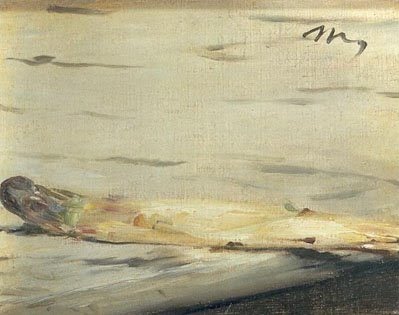
friend Markus Krottendorfer for an afternoon, who was out day and night documenting the whole
trip of the shuttle. I’m not too interested in spacecrafts, I was there because I like crowds. Especiallygood looking kids of 16 or 17. I don’t even remember taking the picture of that lady but I really liked it once I saw it.
The donkey and gloved hand image is from a comic called Happy! by Grant Morrison and Darick Robertson.
KA: If you could own any piece of art in the world, what would it be?
LS: Manet’s single asparagus.
Charity Points.
May 1st, 2013
May 2013 Curator Adam Lindemann versus May 2013 Artist Charles Harlan.
Narrow Objecthood
April 1st, 2013
Rebecca Morse, Associate Curator at LACMA, interviews artist Sam Falls for the April 2013 edition of the Artist of the Month Club.
Rebecca Morse: You work in a range of mediums, which reflects your background in painting, graphic design, and photography. However, your approach is decidedly photographic in that it is often about the passing of time and light, do you see this as the dominant through-line in your work?

Sam Falls: To a degree, I like to think that I’ve taken the defining or theoretical elements of photography and abandoned its narrow objecthood or professional materials. So I’m conceptually engaged with light, time, and representations, but materially working with an everyday vernacular that has lent itself more openly to painting, sculpture, and installation. The jumping off point is often photographic in theory then, but the end point is something totally different with the concept still preserved. I think the work then floats in an undefined area of art which is very exciting.
RM: This aggregate of mediums works against the idea of a singular isolated image, making the passage of time more readily felt in the objects themselves. Is this a conscientious approach to something you see as largely absent from photographs?
SF: Yes, exactly. I find photographs themselves to be quite alienating for the viewer – always distanced from the moment of production in regards to a photograph, as well as the homogeneity of photographic paper, it’s a leveling that not only isolates the viewer but the subject and artist as well. The process of working on a photograph digitally and then again physically creates a linear timeline of production and gives life to the object over time, so by the time it reaches the viewer they are incorporated to a degree in that artistic process. The physicality of the object becomes present to by using it as a printing tool, and my hand also is visible, which I see as the inviting nature of painting. The works left in the sun or rain also inherit time by the very nature of their durational production, and that duration is what eventually produces the image which I find to be in nice opposition to the instantaneous nature of traditional photographic production.
RM: Fighting against the emptiness of commercial photography and desiring to give more to the viewer’s emotions, your work rests on a fine line between conceptual and personal, how do you set out to achieve that balance?

SF: I think it’s merged, the conceptual and personal. No matter how conceptual the work is, that concept comes from my experience and the desire to dedicate my life to producing this work is a very personal decision and I think the work carries this feeling. The work deals with time and time as a universal issue everyone has to deal with. The subject matter is a sign of where I am geographically and mentally, but also my relationship to art history and obsession with the place of art. I believe in a progressive art and there’s a lot of work to do. I actually see conceptual art as the more universal and accessible side to art and I try to leave a place for the viewer’s history rather then tell the whole story through my emotions. But then I’m a viewer of my own art as well.
RM: You clearly have an affinity for being in the landscape and have found a compelling way to focus on the elements as subject rather than the landscape itself, has this been heightened since your move to California in 2011?
SF: Yes, and that’s part of the reason I moved to California. I noticed the rain for example, since it’s a special occurrence here, unlike New York. And the approach is quite collaborative, I think of it existing in a space between land art and studio practice. It’s like camping rather than building a house. The potential of synthesizing the outdoors with the indoors appears limitless to me and California feels like the best place for it!
a collective free association
March 1st, 2013
Omar Lopez-Chahoud interviews artist David Brooks for the March 2013 edition of the Artist of the Month Club.
Omar Lopez-Chahoud (OLC): How is the edition for INVISIBLE-EXPORTS connected to the larger project at Storm king Art Center that is currently on view?
David Brooks (DB): I used the opportunity at Invisible Exports to create a print edition that functions not only as works in their own right, but that also act as a kind of circulating back-story to the larger sculptural installation at Storm King Art Center. The project at Storm King is titled A Proverbial Machine in the Garden. The notion of a machine in the garden is a cultural symbol that underlies the tension between the pastoral ideal and the rapid and sweeping transformations wrought by industrialized technology. Within the American mythology, “nature” is often symbolized by a garden, while a machine invading the garden often symbolizes “technology”. Cultural historian Leo Marx underlines this idea in his seminal text, The Machine in the Garden: Technology and the Pastoral Ideal in America (1964). Historically, this metaphor is often expressed through the abrupt and confrontational intrusion of technology into a tranquil pastoral scene. This metaphor points back to the peak of the industrial era in 19th century America and Europe, but is also a metaphor that we are still living out today.
The actual sculptural installation at Storm King comprises a 1970s-model Dynahoe tractor, complete with backhoe and front-end loader, that has been buried in a hillside in Storm King’s iconic landscape. Specific areas of the machine—like the excavating and loading buckets, and part of its cab—were chosen to be framed out in concrete shaftways left open to the sky, while the remaining body of the tractor is buried beneath the earthen hillside. Visitors are invited to stand on the shaftways’ steel gratings and peer down into the exposed compartments of the tractor below the earth. Speaking to Storm King’s past—as an agricultural site—and present—as a carefully sculpted pastoral environment—A Proverbial Machine in the Garden looks at how humans use, consume, and perceive of this particular aspect of the natural world. The buried tractor is symbolic of both farming and land-moving machinery that helped to build Storm King’s pastoral “natural” environment, while equally pointing towards the future of an increasingly globalized capitalist network consuming the landscapes of every continent.
The cyanotype print done for Invisible Exports can be seen as a schematic illustration of this cultural construction, but realized and articulated in a collective manner.
OLC: Why a print edition?
DB: A print edition like this allows for the concepts and concerns of a fairly intricate project to take on a different kind of fluidity. It’s almost like bringing aphoristic excerpts into high relief, allowing them to act independently from a denser text.
It was important that this particular print edition was an edition of cyanotypes – all of which are inherently unique, differing slightly in tone and exposure from each other since they were exposed directly by the sun. In this way the cyanotypes enact and engage some of the very elements (e.g. the sun and the elements) that the conceptual context insinuates.
Following the same conceit, it was important that the edition was approached collectively. Since the historical trope being described (the machine in the garden) is a cultural trope constructed collectively over the last two centuries, it was imperative to have an audience enact and engage the process of identifying with the concerns surrounding the work, rather than myself didactically speaking at the audience.
OLC: How is the audience collaborating with the print edition?
DB: It’s quite simple. I have assembled an ongoing list of words, a lexicon so to speak, that pertains to the A Proverbial Machine in the Garden project as a whole. These are words that I have taken from Leo Marx’s text, as well as the Farmers’ Almanac and other sources, that are words commonly associated with themes of the “pastoral” and the industrial era. Sixty different people, or “writers” as they are called, will choose 6 words from this list, or they may add words of their choosing to this ever-growing lexicon. On the cyanotype print you will see there are 6 lines that draw indication arrows to specific components of the tractor on the blueprint. The writers will write, in red correction marker and in their own handwriting, their 6 chosen words on the blank lines of the indication arrows on the print, indicating the tractor component they feel is most appropriate for each chosen word. My hand will be absent.
Ultimately, each print will have a unique set of words written in on it, and a different handwriting will execute each print. This process grants a uniqueness to each blueprint, and the social construction of the “Machine in the Garden” is thus enacted collectively.
OLC: Do you see it evolving into something else?
DB: I think this process of generating a collective-social imaginary is an interesting way to flesh out the back-story to seemingly convoluted projects. So, yes, I think it will evolve. Especially, if/when this entire edition could ever be seen together in the future. The idiosyncrasies in peoples’ word choices will begin to stand out in high relief, allowing them to simultaneously act independently as well as collectively as both a series and as a cohesive idea. They become subjective aphorisms while also adding up to something larger than themselves.
[lexicon listed below]
Baby Making: February 2013
February 28th, 2013
February 2013 curator Deborah Brown, owner of Brooklyn gallery Storefront Bushwick, interviews February 2013 artist Adam Parker Smith.
Deborah Brown: You grew up in Humboldt County, California, the marijuana-growing capital of the U.S. Did this backdrop of subversive culture and capitalism influence you as an artist?
Adam Parker Smith: Yes. The most prominent message in both Humboldt County and the home that I was raised in was; “Think for yourself.”
DB: In your work, you appear to have a love-hate relationship with popular and high culture. What is your favorite pop culture image or object and, conversely, what is your favorite work of “high art”? Discuss their relationship to your work and process.
APS: I don’t think I am a true fan of either popular or high culture. I am a fan of the fans. There was no television in my family’s house when I was growing up, and living in such a remote location, I didn’t visit my first major museum until I was 19. I think because of this I have always been more of an observer of other people’s infatuations with pop culture and high art and this is what really informs my work.
DB: Is this the reason you incorporate images of celebrities and their artifacts in your pieces? What is the relationship of your work to our culture of narcissism, fetishism, and celebrity idolatry?
APS: Exactly. Celebrities are extensions of us. They are what we think we want to look like and we think we want to live like. One approach is this: If you want people to like your work, and you know that they love themselves, then what makes sense is to make work about them.
DB: You started out as a painter, but your current work appears to have little indebtedness to painting. How did you get from there to where you are now?
APS: I love to paint and draw, but I could never find myself as a painter. It didn’t click for me. I think about painting all the time, and I will paint again. Someday I would like to only make paintings and nothing else. I think the best way to describe my current practice in relation to painting is that I am on a long vision quest with the work I make now, looking for guidance for the paintings I will make someday in the future.
DB: You have been known to purchase ideas from other artists that you have gone on to make into your own artworks. What got you started on this practice?
APS: Artist block.
DB: When you buy an idea from another artist, what makes it your art other than your decision to execute it in your name?
APS: Nothing except that and the piece gets filtered through my creative process. I went to a lecture ten years ago that Mark Kostabi gave that still resonates with me. Kostabi is known for openly employing numerous painting assistants and idea people. At one point somebody from the audience asked him if his employees’ names appeared anywhere or if they were given credit. He responded; “Yes, on their checks.” It doesn’t make sense to me that an idea could be intrinsically mine. That would be impossible. Most of the time, nobody gets any credit or compensation for the ideas that are appropriated or stolen from them. Buying ideas is a small amelioration for that.
DB: Your work reflects a fascination with the male organ. Recent “identity-based” art has been critical of the white male perspective and its “privileging of the phallus.” How do you get off the hook in using this imagery in a seemingly flat-footed, uncritical manner? Is your work “post-identity”?
APS: So we are talking about allegedly navigating a post-identity politics landscape in the art world. This for me is actually pretty terrifying, because a backfire is always possible. Progress can’t be accomplished without risk, so to gamble with my practice and my career is essential for its development. This doesn’t make me any less nervous with many of the pieces I make. I do a lot of crossing fingers and holding breath, and people let you know when you step too far over the line. With luck those types of conversations will happen before the work leaves the studio. As far as getting off the hook is concerned, I could say that this “progress” is part of a cathartic discourse to heal our history of gross abuse, neglect and inequality, but I won’t. I think people are just ready to have a little fun.
DB: How important is it to you to make permanent objects versus installations such as the one in “This Side of Paradise” for the Andrew Freedman House, which are temporary and ephemeral?
APS: I try not to make too many rules for myself in my practice. There are already so many restrictions in place that I have no control over, like space and time and manpower. I like to let myself use whatever I feel like using. So far I feel like I have struck a good balance and for the most part I have been allowing myself as many options as possible.
DB: What’s your dream project and how likely are you to realize it in the near future?
APS: Making a baby. Due date- May 24th 2013.
2013: Year of the Relaunch!
January 1st, 2013

Hello out there you AMC-ites. 2013 is the relaunch of our beloved interview series between AMC curators and artists. Check back in to see what makes our AMC artists tick, and get a peek inside their brains. ARTIST OF THE MONTH CLUB is not responsible for changes in worldly outlook that may occur.


